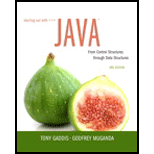
Starting Out with Java: From Control Structures through Data Structures (3rd Edition)
3rd Edition
ISBN: 9780134038179
Author: Tony Gaddis, Godfrey Muganda
Publisher: PEARSON
expand_more
expand_more
format_list_bulleted
Textbook Question
Chapter 19.6, Problem 19.33CP
How do you define a stream of elements?
Expert Solution & Answer
Trending nowThis is a popular solution!

Students have asked these similar questions
4. |z + 5 - 5i| = 7
14.
dz,
C: |z❘
C: |z❘ = 0.6
ze² - 2iz
H
14.
dz,
C: |z❘
C: |z❘ = 0.6
ze² - 2iz
H
Chapter 19 Solutions
Starting Out with Java: From Control Structures through Data Structures (3rd Edition)
Ch. 19.1 - Prob. 19.1CPCh. 19.1 - What are the three general types of collections?Ch. 19.1 - Prob. 19.3CPCh. 19.1 - Prob. 19.4CPCh. 19.1 - Prob. 19.5CPCh. 19.1 - Prob. 19.6CPCh. 19.1 - Prob. 19.7CPCh. 19.2 - Prob. 19.8CPCh. 19.2 - Prob. 19.9CPCh. 19.2 - Prob. 19.10CP
Ch. 19.2 - Prob. 19.11CPCh. 19.2 - Prob. 19.12CPCh. 19.2 - Prob. 19.13CPCh. 19.2 - Prob. 19.14CPCh. 19.2 - Prob. 19.16CPCh. 19.2 - Prob. 19.17CPCh. 19.2 - Prob. 19.18CPCh. 19.2 - Prob. 19.20CPCh. 19.3 - Prob. 19.21CPCh. 19.3 - Prob. 19.22CPCh. 19.3 - Prob. 19.23CPCh. 19.3 - Prob. 19.24CPCh. 19.3 - Any time you override the Object classs equals...Ch. 19.3 - Prob. 19.26CPCh. 19.3 - Prob. 19.27CPCh. 19.3 - Prob. 19.28CPCh. 19.4 - Prob. 19.29CPCh. 19.4 - Prob. 19.31CPCh. 19.4 - Prob. 19.32CPCh. 19.6 - How do you define a stream of elements?Ch. 19.6 - How does a stream intermediate operation differ...Ch. 19.6 - Prob. 19.35CPCh. 19.6 - Prob. 19.36CPCh. 19.6 - Prob. 19.37CPCh. 19.6 - Prob. 19.38CPCh. 19.6 - Prob. 19.39CPCh. 19 - Prob. 1MCCh. 19 - Prob. 2MCCh. 19 - This type of collection is optimized for...Ch. 19 - Prob. 4MCCh. 19 - A terminal operation in a stream pipeline is also...Ch. 19 - Prob. 6MCCh. 19 - Prob. 7MCCh. 19 - This List Iterator method replaces an existing...Ch. 19 - Prob. 9MCCh. 19 - Prob. 10MCCh. 19 - This is an object that can compare two other...Ch. 19 - This class provides numerous static methods that...Ch. 19 - Prob. 13MCCh. 19 - Prob. 14MCCh. 19 - Prob. 15TFCh. 19 - Prob. 16TFCh. 19 - Prob. 17TFCh. 19 - Prob. 18TFCh. 19 - Prob. 19TFCh. 19 - Prob. 20TFCh. 19 - Prob. 21TFCh. 19 - Prob. 22TFCh. 19 - Prob. 1FTECh. 19 - Prob. 2FTECh. 19 - Prob. 3FTECh. 19 - Prob. 4FTECh. 19 - Write a statement that declares a List reference...Ch. 19 - Prob. 2AWCh. 19 - Assume that it references a newly created iterator...Ch. 19 - Prob. 4AWCh. 19 - Prob. 2SACh. 19 - Prob. 4SACh. 19 - Prob. 5SACh. 19 - Prob. 6SACh. 19 - How does the Java compiler process an enhanced for...Ch. 19 - Prob. 8SACh. 19 - Prob. 9SACh. 19 - Prob. 10SACh. 19 - Prob. 11SACh. 19 - Prob. 12SACh. 19 - Prob. 13SACh. 19 - Prob. 14SACh. 19 - Word Set Write an application that reads a line of...Ch. 19 - Prob. 3PCCh. 19 - Prob. 5PCCh. 19 - Prob. 8PC
Additional Engineering Textbook Solutions
Find more solutions based on key concepts
In each case, the beam is subjected to the loadings shown. Draw the free-body diagram of the beam, and sketch t...
Mechanics of Materials (10th Edition)
What are the advantages in implementing a language with a pure interpreter?
Concepts Of Programming Languages
Figure 1-30 shows the Visual Studio IDE. What are the names of the four areas indicated in the figure? Figure 1...
Starting Out With Visual Basic (8th Edition)
CONCEPT QUESTIONS
15.CQ3 The ball rolls without slipping on the fixed surface as shown. What is the direction ...
Vector Mechanics for Engineers: Statics and Dynamics
Consider the following program: a. What output does the program produce? b. What output would the program produ...
Java: An Introduction to Problem Solving and Programming (8th Edition)
Assume a telephone signal travels through a cable at two-thirds the speed of light. How long does it take the s...
Electric Circuits. (11th Edition)
Knowledge Booster
Learn more about
Need a deep-dive on the concept behind this application? Look no further. Learn more about this topic, computer-science and related others by exploring similar questions and additional content below.Similar questions
arrow_back_ios
SEE MORE QUESTIONS
arrow_forward_ios
Recommended textbooks for you
 New Perspectives on HTML5, CSS3, and JavaScriptComputer ScienceISBN:9781305503922Author:Patrick M. CareyPublisher:Cengage Learning
New Perspectives on HTML5, CSS3, and JavaScriptComputer ScienceISBN:9781305503922Author:Patrick M. CareyPublisher:Cengage Learning EBK JAVA PROGRAMMINGComputer ScienceISBN:9781337671385Author:FARRELLPublisher:CENGAGE LEARNING - CONSIGNMENT
EBK JAVA PROGRAMMINGComputer ScienceISBN:9781337671385Author:FARRELLPublisher:CENGAGE LEARNING - CONSIGNMENT C++ Programming: From Problem Analysis to Program...Computer ScienceISBN:9781337102087Author:D. S. MalikPublisher:Cengage Learning
C++ Programming: From Problem Analysis to Program...Computer ScienceISBN:9781337102087Author:D. S. MalikPublisher:Cengage Learning Microsoft Visual C#Computer ScienceISBN:9781337102100Author:Joyce, Farrell.Publisher:Cengage Learning,
Microsoft Visual C#Computer ScienceISBN:9781337102100Author:Joyce, Farrell.Publisher:Cengage Learning, Systems ArchitectureComputer ScienceISBN:9781305080195Author:Stephen D. BurdPublisher:Cengage LearningProgramming Logic & Design ComprehensiveComputer ScienceISBN:9781337669405Author:FARRELLPublisher:Cengage
Systems ArchitectureComputer ScienceISBN:9781305080195Author:Stephen D. BurdPublisher:Cengage LearningProgramming Logic & Design ComprehensiveComputer ScienceISBN:9781337669405Author:FARRELLPublisher:Cengage

New Perspectives on HTML5, CSS3, and JavaScript
Computer Science
ISBN:9781305503922
Author:Patrick M. Carey
Publisher:Cengage Learning

EBK JAVA PROGRAMMING
Computer Science
ISBN:9781337671385
Author:FARRELL
Publisher:CENGAGE LEARNING - CONSIGNMENT

C++ Programming: From Problem Analysis to Program...
Computer Science
ISBN:9781337102087
Author:D. S. Malik
Publisher:Cengage Learning

Microsoft Visual C#
Computer Science
ISBN:9781337102100
Author:Joyce, Farrell.
Publisher:Cengage Learning,

Systems Architecture
Computer Science
ISBN:9781305080195
Author:Stephen D. Burd
Publisher:Cengage Learning

Programming Logic & Design Comprehensive
Computer Science
ISBN:9781337669405
Author:FARRELL
Publisher:Cengage
1.1 Arrays in Data Structure | Declaration, Initialization, Memory representation; Author: Jenny's lectures CS/IT NET&JRF;https://www.youtube.com/watch?v=AT14lCXuMKI;License: Standard YouTube License, CC-BY
Definition of Array; Author: Neso Academy;https://www.youtube.com/watch?v=55l-aZ7_F24;License: Standard Youtube License